AI at Work
Image Personalization: Best Practices for Personalizing Images to Target Audiences

Matthew Loewengart · Strategic Solutions Architect
May 14th, 2025 · 14 min read
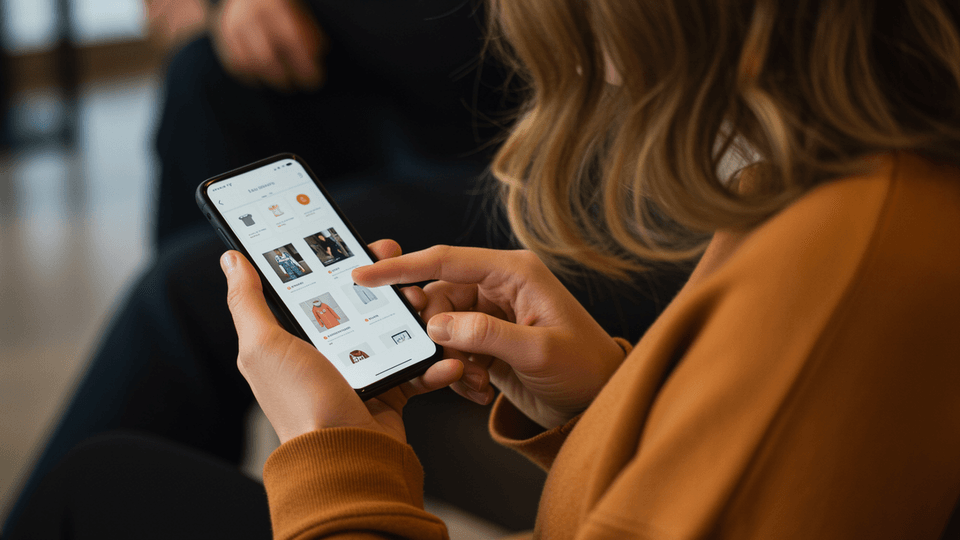
Image personalization is one of the most powerful yet underutilized tools in a marketer's arsenal. While marketing teams have made significant strides in content personalization, visual content often remains static and undifferentiated. They invest valuable time in audience research only to serve identical images to their entire customer base, ignoring the visual dimension of personalization entirely. This is precisely the gap that Typeface addresses. This multimodal AI content platform offers enterprise-grade solutions that allow sophisticated image personalization while maintaining perfect alignment with established brand guidelines, campaign briefs and audience segments.
The following guide explores proven best practices and actionable techniques to implement AI-powered creative personalization that creates meaningful connections with your audience and elevates your brand communications.
Why image personalization matters
How to personalize your images with Typeface
Best practices for image personalization
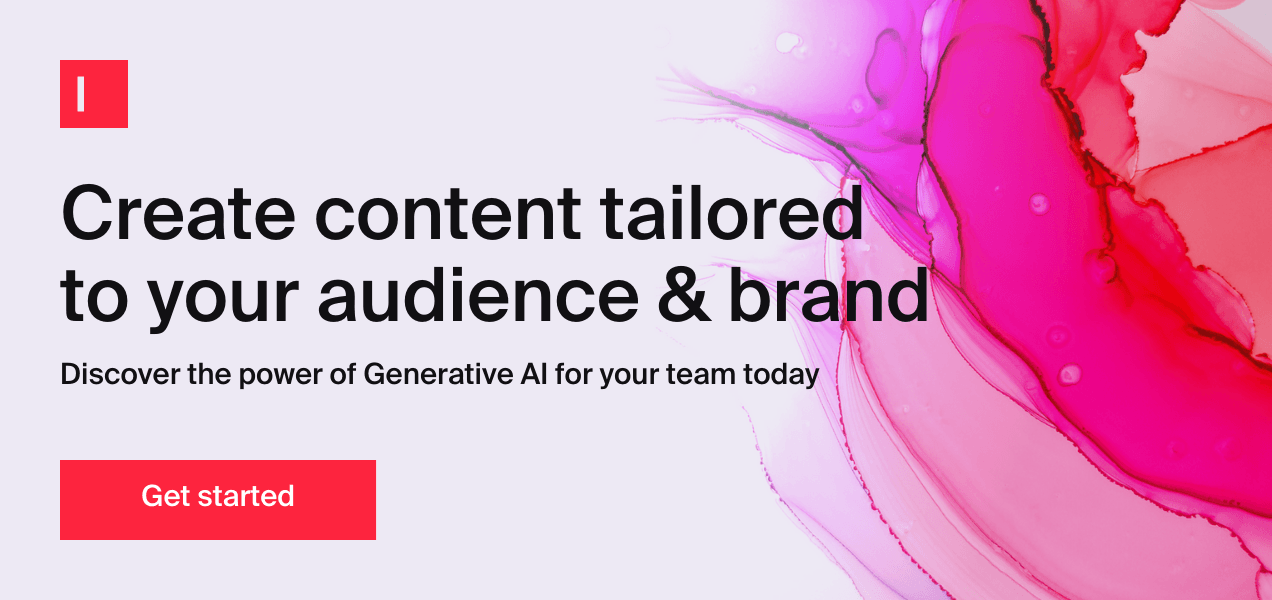
Why image personalization matters
Research shows that consumers have a strong preference for personalized experiences. 72% of them expect companies to see them as unique individuals and understand their specific interests, rather than treating them like just another data point. This expectation naturally extends to the visuals used in marketing campaigns. When customers see images that reflect their preferences and needs, they are more likely to engage with the content and take action.
Visual personalization creates a powerful connection that generic images simply cannot match. In a market saturated with marketing messages, personalized visuals create engaging experiences that capture attention. Many leading organizations are now deploying personalization to adapt visuals based on individual customer journeys, demographic profiles, and behavioral patterns.
Netflix's personalization strategy is one example. With 216 million users, each experiencing a unique homepage tailored to their viewing preferences, the platform has mastered the art of search personalization, where images play a very important part.
At the core of Netflix's services are its recommendation and search algorithms, which offer personalized entertainment suggestions to members worldwide, perfectly aligning with their preferences at any moment. The platform understands that different viewers can enjoy the same content for entirely different reasons. By developing multiple promotional artworks for a single title, they can speak to diverse audience segments and maximize engagement.
Take the Netflix title Purple Hearts for example. Instead of relying on a single visual narrative, Netflix crafts several different variations that will resonate with unique audience segments. Romance enthusiasts might see artwork highlighting interpersonal dynamics, while viewers drawn to military history and war narratives encounter different visuals.
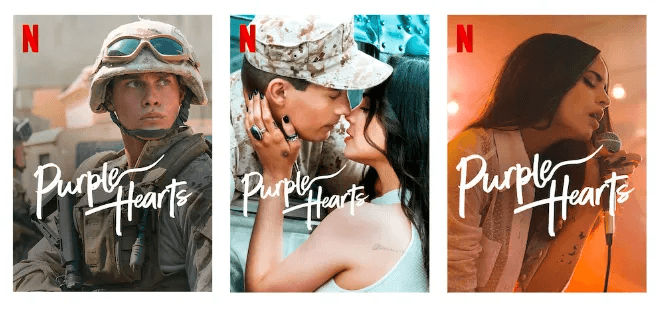
But the problem with creative personalization is that it can take up a lot of time, which often results in generic images that barely scratch the surface of true personalization. Even well-resourced marketing teams struggle to produce more than a handful of audience-specific image variants, making it difficult to scale up effectively. Typeface’s AI content personalization capabilities solve this by allowing businesses to import a broad range of targeted audience segments and use them to generate relevant creatives and copy. The next section explores how that works.
How to personalize your images with Typeface
Step 1: Unlock deeper audience insights
Even after significant investments in customer data collection, many organizations struggle to extract meaningful audience insights from their raw data. AI-enabled consumer intelligence platforms can provide the critical bridge here—detecting subtle patterns within your existing data and revealing customer preferences and behavioral signals that could inform your personalization strategy.
Complement this approach with website engagement analytics tools that quantify how different customer segments interact with your web content. By analyzing clicks, cursor movements, and heat maps, you can identify which visual elements on your website resonate with specific buyer personas throughout their decision journey.
Social media engagement analytics tools can reveal another critical dimension. Your audience may exhibit entirely different preferences across LinkedIn, Instagram, and other digital platforms, and these tools further micro-target audiences and allow for further analysis of what style content resonates with a particular segment.
The granular audience insights gained from this exercise become your foundation for your content personalization strategy.
Step 2. Use these insights to set up audience profiles on Typeface
To create audience profiles on the platform, you can use two methods on the platform:
1. Importing audience segments through CDP connectors
With our connectors, teams can import audience segments from wherever you are managing your segmentation (e.g. CRM and customer data platforms, like Salesforce Data Cloud, Google Big Query, Klaviyo, HubSpot, or Braze, directly into Typeface. Once you've connected the CDP to Typeface (which requires a simple one-time setup with an API key), open the Audiences section, click on 'Import', and select your data source.

After that, determine how recent you would like to import audience. You can also enable automatic syncing to keep your audiences continuously updated when new audiences are created or changes to the audience traits occur. Typeface applies the key attributes and traits from your CDP and uses natural language processing to convert them into easy-to-understand personas.
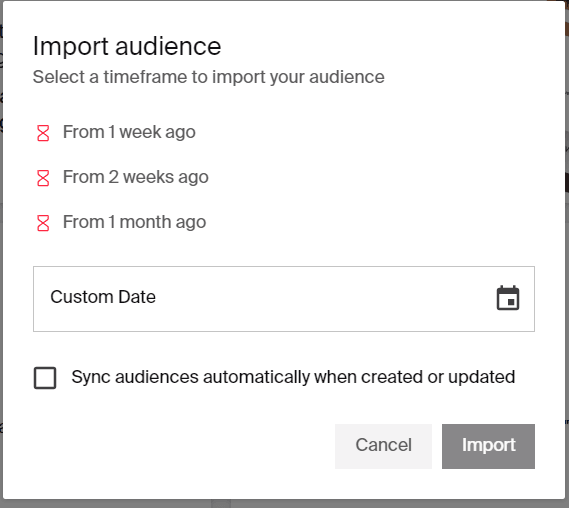
2. Manually creating audience segments
To do this manually, navigate to the Audiences section on Typeface, click on 'New Audience' and input essential details, like segment name, age range, and gender targeting preferences. You can specify the shared behaviors, traits, hobbies, and preferences and classify the audience by their spending habits, such as "luxury spender," "budget-conscious," or "value-oriented."
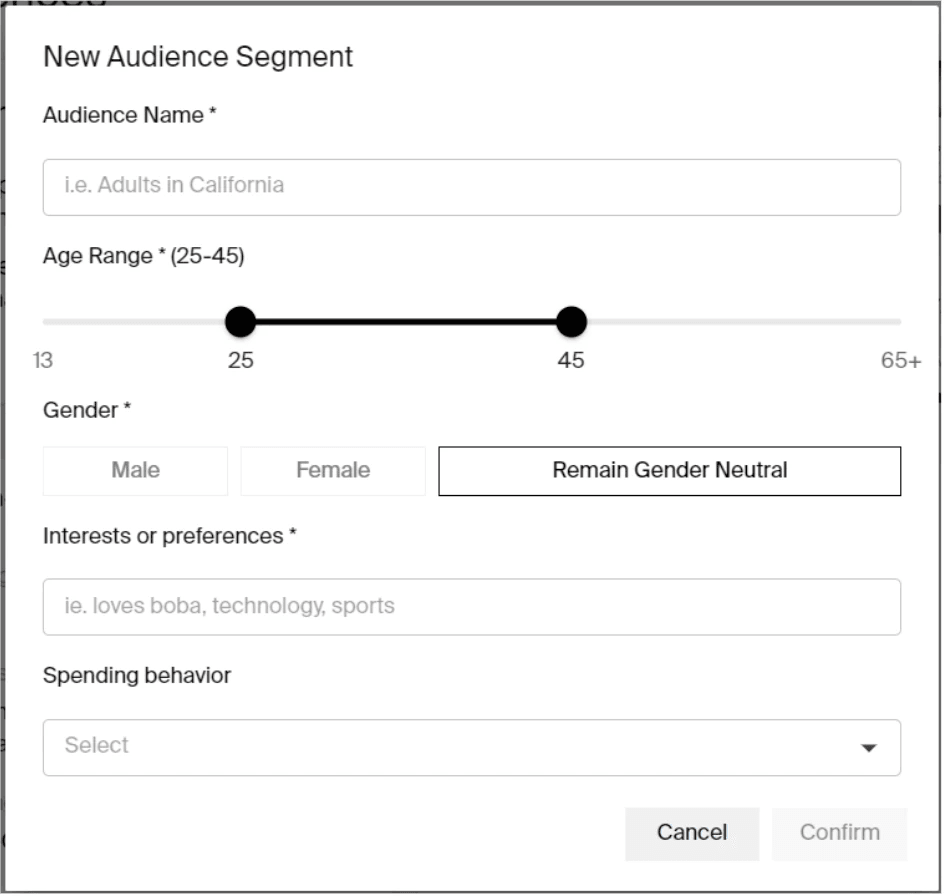
By creating audience segments, your content creation workflow leverages audience interest to ensure that images are harmonized to fit your audience's unique specifications.
Step 3. Set up visual rules and image styles to ensure brand consistency
The next step is to incorporate your brand's visual identity into Typeface's Brand Hub. This integrated brand intelligence system brings together all your brand assets, guidelines, and performance analytics into one easy-to-navigate repository.
To set it up, you have several options: add a connector to share the style guide, upload it directly from your system, or add a publicly shareable URL. Typeface pulls out the brand rules from the uploaded guide, and brand managers can review and finalize the extracted rules before making them accessible to the team for creating on-brand content.
Working in tandem with Brand Hub, Typeface's Brand Agent automatically checks your visual content across all channels to ensure it follows your brand guidelines. Beyond just identifying inconsistencies, it actively recommends adjustments and ensures that visual content and marketing materials consistently align with your brand standards.
With this, you can create a self-enforcing brand governance system that maintains visual consistency across all digital touchpoints while allowing for audience-specific personalization.
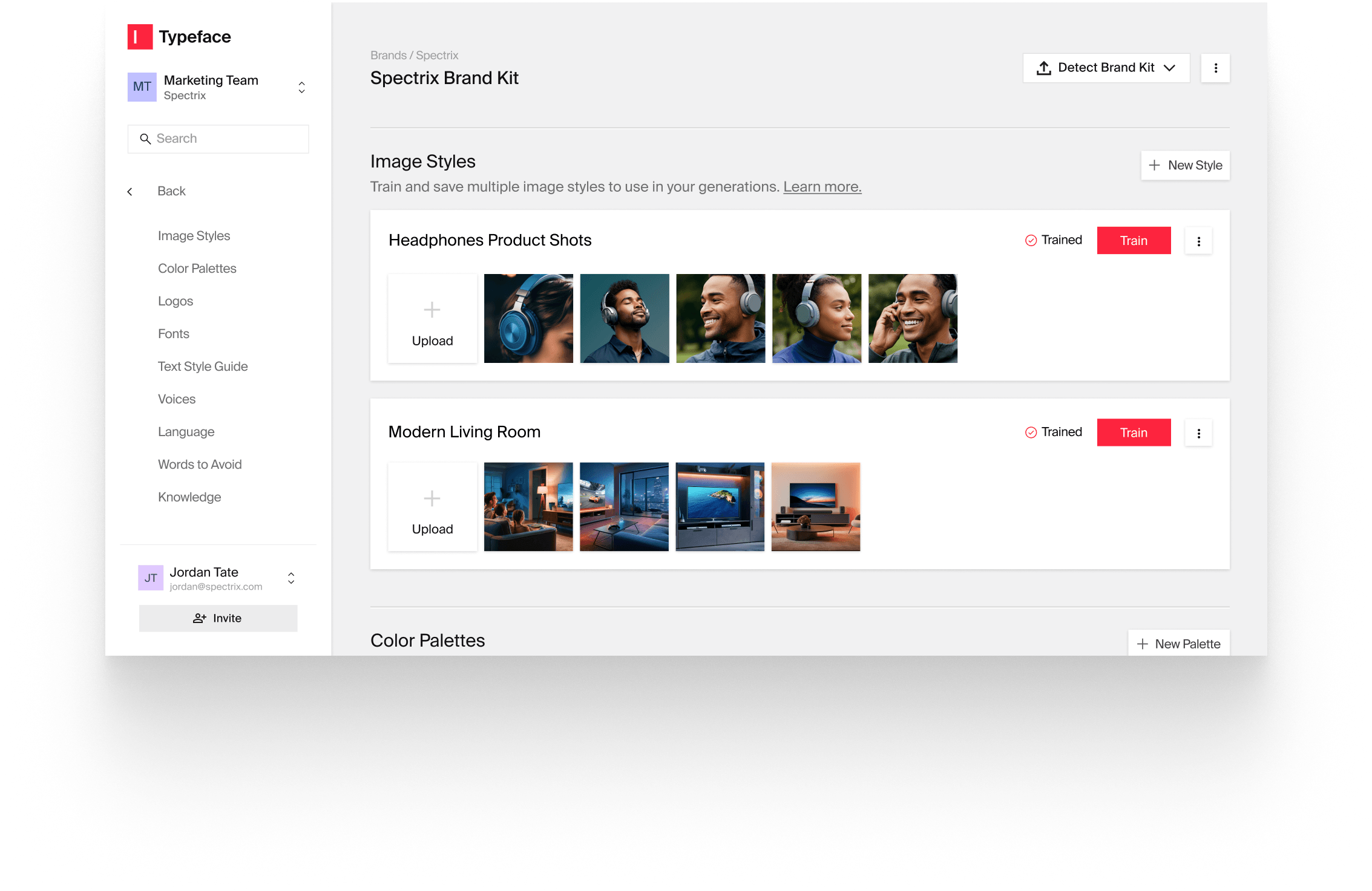
To manually set up a new image styles on Typeface, you upload 10-15 high-quality images that represent a specific aesthetic, visual style, or composition. The image styles can be used to identify a style of photography or illustration. Image Styles can further be used to identify architecture styles, local trends, or reinforce unique price points. They ensure that your brand is visually represented in the creative produced by Typeface.
Once you train the AI on these images, the Brand Hub further codifies your brand's unique visual attributes—from color palettes and compositional patterns to texture treatments and subject framing approaches. This process creates a visual brand language that ensures every AI-generated image stays true to your brand. It also frees you from having to meticulously input specific brand details each time you generate images on the platform.
Step 4. Generate personalized images with Visual Inspiration Studio
With your audience profiles, brand kit, and image styles defined, it's time to bring your personalized visuals to life through Typeface's AI image generation workflows. The platform offers two different approaches—AI text-to-image generation and the Visual Inspiration Studio. While custom AI image prompts can work, Visual Inspiration Studio elevates your creative personalization process in several key ways. Instead of starting with a blank canvas, the Studio offers a library of reference images categorized by different settings and backgrounds to kickstart your creativity. The Studio then allows you to layer in your brand assets (e.g. Product imagery and logos) along with your audience details. This creates a contextual framework that guides the AI to blend these elements naturally.
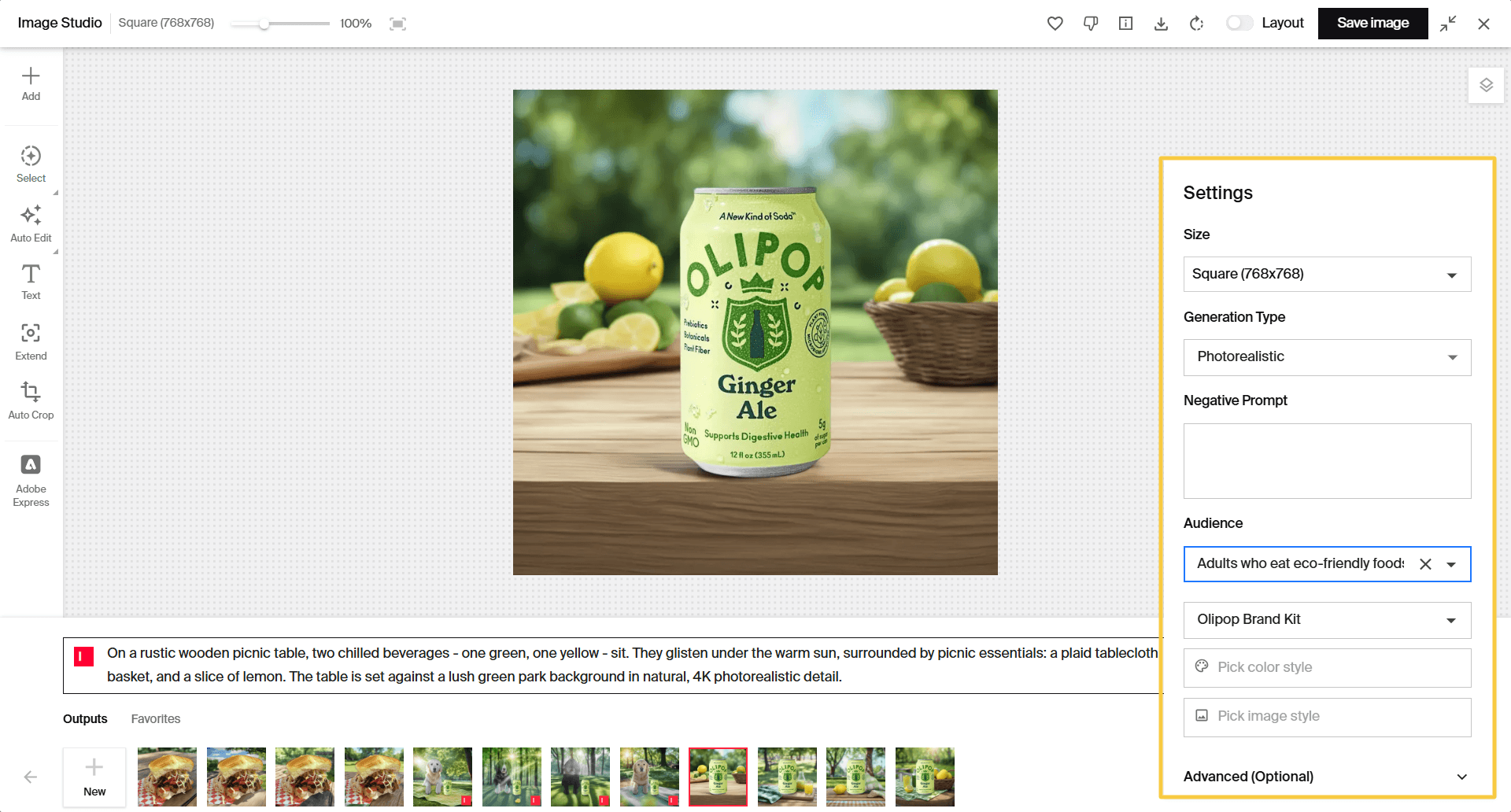
This visual-first approach to defining your composition provides concrete direction to Typeface rather than abstract prompts that may miss the mark.
Best practices for image and creative personalization
Now that you know the basics of image and creative personalization with Typeface, here are some best practices to consider:
1. Match representation for underserved audiences
Study local customs, symbolism, and visual preferences meticulously. By presenting imagery that honors the nuanced cultural codes, sensitivities, and daily realities of your target audience, you transform visual communication into a powerful trust-building asset. In markets where cultural authenticity matters intensely, this attention to detail transforms passive scrolling into meaningful engagement with your brand.
2. Transcreation
True image personalization requires more than surface-level adjustments—it demands a sophisticated understanding of regional preferences, cultural contexts, and localized visual languages. Achieving this cultural relevance while maintaining your intended emotional impact is the delicate balance of transcreation. Cultural symbols carry profound but vastly different meanings across borders: white evokes purity in Western contexts but signifies mourning throughout many Asian cultures; circular compositions might suggest harmony in some regions while implying emptiness in others; even hand gestures can hold different meanings in different parts of the world. These subtle variations can transform an image's entire emotional landscape.
Consider how visual representation of a kitchen in Tokyo will look dramatically different than one in Dallas. In Tokyo, spatial efficiency might showcase compact appliances, minimalist storage solutions, and multipurpose cooking areas that reflect urban living constraints. Meanwhile, a Dallas kitchen might feature expansive countertops, large entertainment islands, and prominent display areas.
Beyond spatial elements, cultural differences appear in everything from food presentation (individual portions in Japan versus family-style serving in Texas), household objects (rice cookers versus slow cookers), and even lighting preferences (soft, diffused lighting versus bright, direct illumination). Even the representation of family and social interactions can vary significantly based on cultural norms and expectations.
Successful visual localization requires more than superficial adaptation. It demands a deep understanding of cultural semiotics—decoding how different communities perceive, interpret, and emotionally connect with visual narratives.
3. Consider generational trends
Visual trends can also vary based on the generation you're targeting. Millennials, who came of age during the rise of Instagram, gravitate toward authenticity and narrative-driven imagery. They seek visual content that tells a story—preferring candid, slightly imperfect shots over highly polished stock photography. Gen Z takes this authenticity mandate even further. Raised on TikTok's rapid-fire storytelling and meme culture's layered irony, they've developed a visual literacy that makes traditional marketing look painfully anachronistic. A single image can communicate multiple levels of irony, social commentary, and emotional nuance.
Notice how brands like Spotify create visualizations that look like they could have been made by the audience themselves—meme-like, slightly raw, but strategically designed. Their year-end "Wrapped" campaign speaks directly to this visual preference.
Color perception and emotional triggers also vary across generations. Gen Z gravitates toward vibrant, almost digital-native color palettes—think neon greens, electric blues, and saturated purples. Older generations often respond to more muted, sophisticated color schemes that suggest reliability and expertise. The most successful brands adapt to these visual preferences, creating a dynamic, ongoing conversation through personalized imagery.
4. Image optimization across platforms and devices
Instead of assuming your brand creatives will translate well across different platforms and devices, it's important to put a little more thought into image and creative optimization. With Typeface’s suite of AI-powered editing tools, you can make these adjustments and optimizations without leaving the platform.
The AI-powered cropping feature intelligently identifies key elements within the image (like products or faces) and automatically crops the image in a way that preserves the focus on these elements, even when adapting to significantly different aspect ratios.
Generative Extend allows users to add "breathing room" or expand backgrounds around the original image non-destructively, ensuring crucial details are not lost when fitting images into larger canvases or different layouts.
The "Select" tool in the Image Studio offers precise control over image modifications. It employs two selection methods: automatic selection, where the AI identifies distinct regions like the sky, background, or specific objects, and a manual brush tool for selecting exact areas. Once an area is selected, users can either "erase" unwanted elements entirely or use a text prompt to "inpaint" – adding or modifying content within the selection. This makes it easier to remove distracting background elements, add relevant objects to enhance the scene, fill in gaps, or subtly modify parts of the image to ensure the overall visual balance is maintained.
For ad creatives specifically, Typeface's Ad Agent intelligently adapts the visuals for different aspect ratios and channels, all while staying within the pre-approved design framework. This way your campaigns maintain visual consistency and impact regardless of where they appear.
5. Test with your actual audience
Visual personalization shouldn't be a guessing game. Simply believing your images will resonate with the target audience isn't enough; you need empirical evidence from the most critical stakeholders: your actual customers.
Before launching any marketing campaign, run targeted experiments with specific audience segments. Design structured A/B tests that compare multiple image variants simultaneously. Track granular metrics like:
Engagement metrics
Conversion rates
Scroll depth
Interaction patterns
And remember that testing isn't a one-time event but a continuous optimization process. Each testing cycle generates actionable intelligence, allowing your visual strategy to evolve. Your imagery becomes a living, adaptive communication system—constantly refined through empirical evidence.
Get started with image and creative personalization
Throughout this blog, we've explored the importance of image and creative personalization, how to implement it using platforms like Typeface, and best practices to ensure your visuals resonate with your audience. By tailoring visuals to meet the specific preferences and interests of your audience, you can create more engaging and impactful content, drive conversions, and build stronger relationships with your audience.
Personalized images have the potential to transform your marketing campaigns, and Typeface bridges the gap between sophisticated personalization and scalable content creation, offering a platform that transforms how brands communicate visually.
Request a demo to talk to our team of experts today.
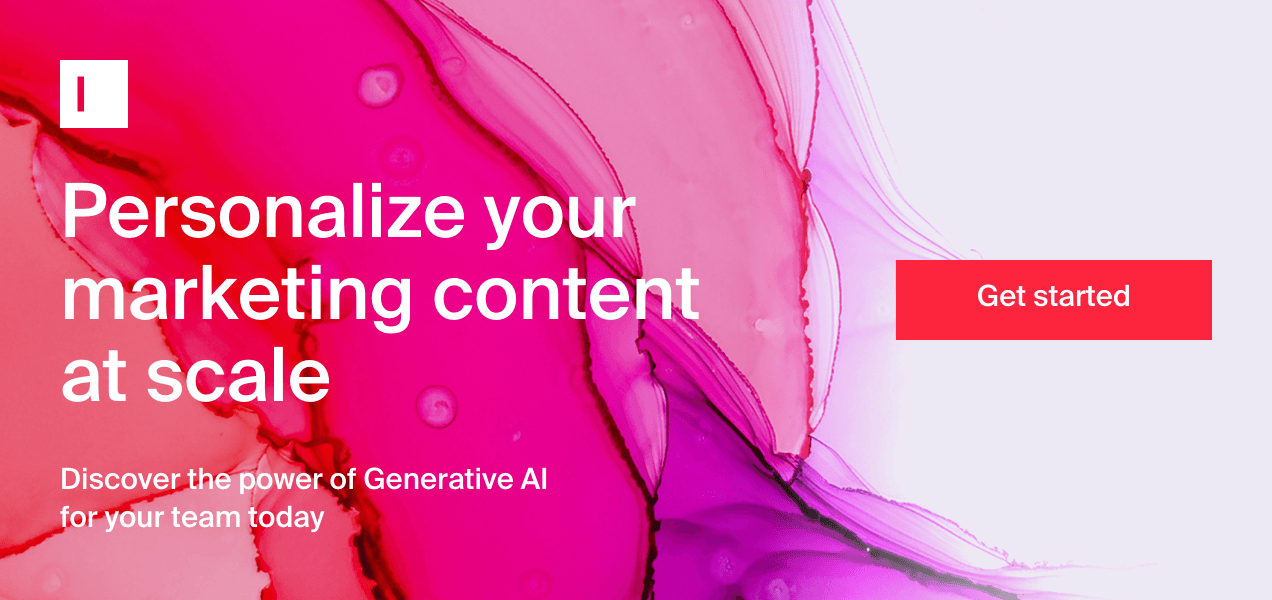
Share
Related articles

AI at Work
50+ AI Image Prompts That Actually Work for Marketing Campaigns

Akshita Sharma · Content Marketing Associate
November 29th, 2024 · 17 min read

AI at Work
How to Use AI Image Generation Tools to Create Holiday Banners for Landing Pages and Ads

Neelam Goswami · Content Marketing Associate
November 27th, 2024 · 16 min read

AI at Work
AI-Generated Image Variations: Scaling Marketing Visuals for Global Markets

Akshita Sharma · Content Marketing Associate
April 29th, 2025 · 9 min read